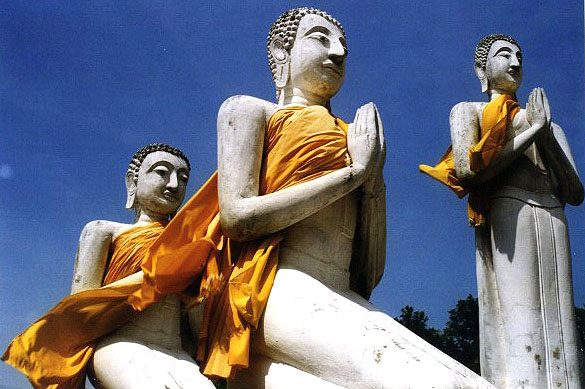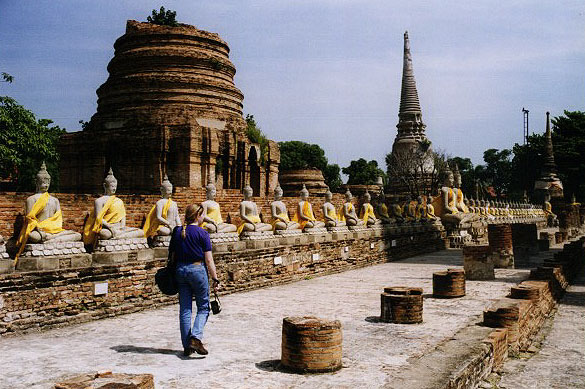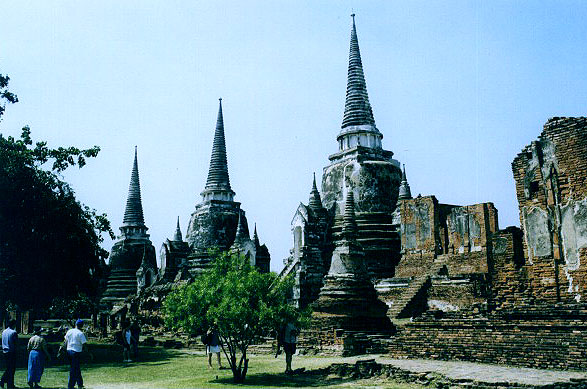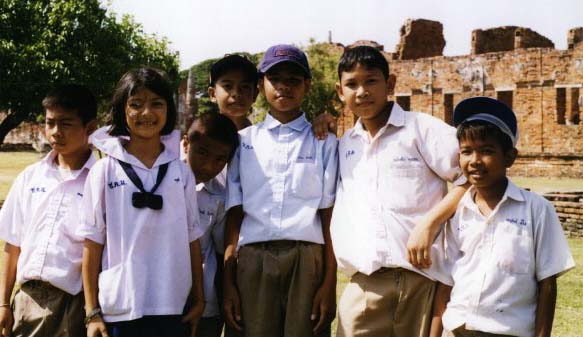 |
| Buddha Statue, Wat Yai Chai Mongkol |
Friday, November 7
Bang Pa-In Palace and the Ruins of Ayutthaya
Susanne and I got up at 6am and ate breakfast downstairs at the Guesthouse Cafe. It was cool and damp outside - I think it might have rained a bit during the night. Today we'd catch a 7am minibus that would take us on a day trip to the ruins of Ayutthaya, the Thai capital from 1359 to 1767. The tour cost 450 baht per person - about 11 dollars each - and it included visits to two of the major ruins, lunch, a short boat ride, and a stop at the 19th century royal retreat, the Bang Pa-In Palace. A minibus drove up a few minutes past seven, so we climbed in with our daypacks, cameras, and plenty of film.
per person - about 11 dollars each - and it included visits to two of the major ruins, lunch, a short boat ride, and a stop at the 19th century royal retreat, the Bang Pa-In Palace. A minibus drove up a few minutes past seven, so we climbed in with our daypacks, cameras, and plenty of film.
The minibus drove us two minutes down to Khao San Road, at which point we were booted out and told to wait for the real minibus. Apparently this bus was just a local pickup service that brings us to the motor pool to wait for our actual ride. We met an Australian college student who was going on the Ayutthaya tour as well. He had been traveling around northern Thailand for a couple of weeks and was just about to wrap up his visit. Within a few minutes, another minibus pulled up, this one cramped with people. The driver opened up the door and shouted "Ayutthaya bus!" The three of us managed to squeeze inside, although there were really only one two seats available. Susanne and I lucked out with the small space near the back of the bus, while the Australian backpacker had to share a single seat with our guide for the day. Lucky for him they were both very thin people.
We drove north for two hours through the morning rush hour traffic and into open highway country. As I did when I arrived in Thailand, I began to have flashbacks of my old home in Florida: expressways, self-pump gas stations, Home Depots and other megastores, strip malls. Even the greenery looked the same, though here they had miles of rice paddies instead of swamp land and savanna. The air conditioning in the van didn't work too well - we'd have phases of cold air, warm air, then cold again. I think the freon only kicked in when the driver had his foot on the gas. On several occasions, we'd exit the highway, do a U-turn, and drive back in the other direction. Several of the passengers started to snicker the third or fourth time this happened. On the fifth occasion, I tried to pay attention to the exits along the highway - it seemed that in this case, you had to be going west in order to catch the next exit. I guess placing exits on both sides of a divided highway wasn't necessarily standard operating procedure here.
We drove through a small town for a few miles before reaching the gates of Bang Pa-In Palace. The current palace was built by Rama V in the 1870s after he paid a visit to the courts of Great Britain and Versailles. Because of his interest in European architecture, much of the palace grounds were modeled on what the king had seen during his travels. The palace itself was immaculate - perfectly manicured lawns, topiaries, weeping willows - I felt I was walking behind the Contemporary Resort Hotel at Disney World. We briefly visited a large Chinese mansion and a lighthouse, but on the whole, our stop at Bang Pa-In was notably unmemorable. Besides, I was eager to eager to see the ruins of Ayutthaya. Ever since visiting the Mayan ruins of Chichen Itza as a kid, I've been enthralled with all things archeological: it was the main reason Susanne and I visited the Nabataean ruins of Petra in Jordan two years ago, and it undoubtedly contributed to our decision to go to Cambodia and its famed city of Angkor. Thailand's most famous archeological sites, Sukhothai and Ayutthaya, were both former capitals of the nation before the monarchy moved the government to Bangkok around 200 years ago. We weren't sure if we'd have time on this trip to visit Sukhothai, six hours to the north, but it was hard to pass up Ayutthaya considering its relative proximity to Bangkok.
The Ayutthaya archeological park is scattered amongst the modern city of Ayutthaya. Most visitors need to hire a taxi to take them around from site to site, which was one of the primary reasons we decided to catch a minibus tour, since in the end a tour would probably cost the same as going up to Ayutthaya on our own. As we drove through modern Ayutthaya, a medium size town, I could see centuries-old stone stupas in the distance. We approached one of the stupas, then drove right past it - it was now the center of a roundabout. Modern Ayutthaya was littered with such random plots of history.
A few minutes later, we reached Wat Yai Chai Mongkol, our first stop in town. The wat dates back to the mid-14th century, when Thai king U Thong constructed a small monastery here for personal meditation. Over the centuries, the wat was expanded to included a massive stone stupa
dates back to the mid-14th century, when Thai king U Thong constructed a small monastery here for personal meditation. Over the centuries, the wat was expanded to included a massive stone stupa that rises some 200 feet into the air. The stupa is surrounded by over a hundred stone Buddha statues, each one of them wrapped in shiny saffron robes, as is the custom in much of southeast Asia.
that rises some 200 feet into the air. The stupa is surrounded by over a hundred stone Buddha statues, each one of them wrapped in shiny saffron robes, as is the custom in much of southeast Asia.
 |
| Buddha statues, Wat Yai Chai Mongkol, Ayutthaya |
The group scattered in all directions once we exited the minibus. Susanne and I walked along the side of the wat past a large stone reclining Buddha. Behind it a large crowd of people entered the ancient wooden sim , an unassuming temple that was easily overshadowed by the tall stone stupa looming behind it. Pilgrims kneeled before a bronze Buddha inside the sim, while others lit oil lamps installed along one side of the temple. There was a large ceremonial gong here - boy, I was tempted to ring it. I assumed it would be a serious faux pas for a farang
, an unassuming temple that was easily overshadowed by the tall stone stupa looming behind it. Pilgrims kneeled before a bronze Buddha inside the sim, while others lit oil lamps installed along one side of the temple. There was a large ceremonial gong here - boy, I was tempted to ring it. I assumed it would be a serious faux pas for a farang such as myself to stroll on over and bang a sacred gong, so I turned and walked away. Then behind me I heard a loud baritone crash - the Thai guide for a French tour group has just hit the gong and was inviting members of her group to give it a shot. Now that the ice was broken, I waited my turn and eventually got hold of the felt covered hammer used to ring this grand old instrument. I gave it a whack in the center and the gong emitted a pleasant ring, much softer than I expected. That tour guide must have really given it all she had, I guess.
such as myself to stroll on over and bang a sacred gong, so I turned and walked away. Then behind me I heard a loud baritone crash - the Thai guide for a French tour group has just hit the gong and was inviting members of her group to give it a shot. Now that the ice was broken, I waited my turn and eventually got hold of the felt covered hammer used to ring this grand old instrument. I gave it a whack in the center and the gong emitted a pleasant ring, much softer than I expected. That tour guide must have really given it all she had, I guess.
 |
| Boulevard of Buddhas, Wat Yai Chai Mongkol, Ayutthaya |
We walked through to the back of the sim and out the other side, where a long row of stone Buddhas hugged the outer pathway of the main stupa. As far as stupas go, this one was impressive. It lacked the colorful mysticism of the stupas of Kathmandu, but I was still quite impressed, probably because of the monstrous stone cold nature of the thing. I climbed its steep steps to an upper platform that afforded a nice view of the scores of Buddha statues below, but I wasn't high enough to see any of the other archeological sites in the distance - too many modern buildings obscured the view. At the center of the stupa, far above the ground, I found crowds checking out a dark stone chamber that wreaked of bat guano. I couldn't see what all the people were looking at, but when I got inside I heard the sound of squeaking bats, undoubtedly annoyed from all of the attention. I pinched my nose and climbed back down to get some pictures of statues around the back of the stupa.
Eventually our group reassembled near the minibus out by the parking lot. Susanne became fascinated with a large rooster that was strutting around the entrance of the park - I don't remember how long she stood there waiting to get a picture of it in mid- cockle doodle doo, but she certainly seemed pleased when the moment finally came.
After a quiet ride in the van, we stopped for lunch at a cozy garden restaurant. We sat right next to one of the canals that surround the perimeter of Ayutthaya and shared a tasty meal of sauteed vegetables, spring rolls, some kind of mild chicken soup, and fried chicken with basil and cauliflower. Susanne didn't trust the food at all and stuck with a plate of hot rice, but I took my chances and tried a bit of everything. I'm sure the food would be OK - besides, I'm vaccinated for hepatitis A and taking multiple daily doses of Pepto Bismol. Up to this point in the minibus tour, none of the group had really talked to each other, apart from their own little cliques. But now people began to open up. We soon learned more about the group: a young Malaysian man who now lived in Australia, a Tamil woman born in Texas but residing in Singapore, four Brits, two Swiss women and the aforementioned young Australian. The Brits, who all appeared like hearty backpacking veterans, kept to themselves the entire time, but the rest of us had a nice conversation about where we all had been, previous travel adventures and the like. Nai, the cheery Malaysian Australian man, possessed a wicked sense of humor and a blunt approach to chit chat. When the two Swiss woman introduced themselves, he immediately quipped, "Oh Switzerland, yes. I hear it's very lovely, but it has a really high suicide rate, right? Nothing better to do, I guess." I think this caught the Swiss off-guard, but no one took offense. Nai seemed to have a scathing comment about all of our home countries at some point.
We closed lunch with some coffee and fresh fruit, including sliced banana, pineapple, and some odd hot pink fruit that tasted (to me, at least) like cheese popcorn. None of us could figure out what it was. Eventually we asked the wait staff and were told that it was papaya - I don't think I ever would have guessed that's what papaya tasted like. At first I really didn't care for it, but after five or six bites it started to grow on me. I figured papaya trees grow everywhere around this part of Asia, so chances are I'd be stuck eating it elsewhere in the trip. Might as well learn to like the stuff.
Back on the bus, we made a quick drive to Vihara Phra Mongkol Bopit, an historic temple popular with Buddhist pilgrims. Inside its sim sits an incredible bronze Buddha statue, one of the largest in southeast Asia. I stood at its pedestal looking upward - I really don't know how tall it was, but I'd guess it was at least 60 feet. It was too dark inside to get a good picture; I wish I had bought a postcard from one of the monks inside. The sim was one of the first built in Ayutthaya, but it was razed to the ground when the Burmese sacked the city in 1767. It took almost 200 years for the Thais to restore the temple to its original splendour, but most visitors today would agree it was well worth the wait.
Our last stop of the day was Wat Phra Si Sanphet, three soaring Ceylonese stupas that stand near the ruins of the royal palace. I was glad they saved the best for last - these stupas were probably the most spectacular ruins in Ayutthaya. Wat Phra Si Sanphet is now a large park, surrounded by numerous trees and thick, flowing grass. We'd have almost two hours to climb among the ruins here, so the group took off in all directions as if we were kids who had just stumbled upon an ancient playground.
 |
| The giant stupas of Wat Phra Si Sanphet, Ayutthaya |
I strolled along the park, amazed at the size and grandeur of the stone stupas. This was the Ayutthaya I had expected. Susanne and I climbed one of the many granite platforms that occupy the space between each stupa. We were approached by a teenaged girl and her mother, who was carrying a large umbrella to keep the sun away. They said hello and asked us where we were from. I immediately took this as an opportunity to try out my Thai - "Phom Cheu Andy, cheu Susanne." The mother and daughter smiled and introduced themselves as well; unfortunately, my ears weren't totally attuned to Thai speech so I had a hard time getting their names. I smiled and responded by asking where they were from: "Khun maa chaak thee nai?" "Maa chaak Lopburi," the girl said. I think Lopburi is north of here, but I had no idea how to ask that in Thai. They then asked us in English if we would pose for a picture, which we did gladly. Thais seemed to enjoy getting pictures of us as much as we liked getting pictures of them, so it was only fair for us to be good sports about it.
We circled the back of the stupas and found a grove of trees to catch some desperately needed shade. Susanne chatted with an English couple that apparently lived somewhere in the US now, though I didn't hear enough of the conversation to find out where. I then noticed a group of uniformed Thai schoolkids who were staring at us across the field. I made eye contact with them and several of the girls giggled. Susanne and I decided to go over and say hello. "Sawatdee khap," I said. "Phom cheu Andy. Cheu Susanne. Pen khon American." One of the smaller boys stepped forward and introduced himself as well. Soon the entire group took their turns saying hello, some using English, some speaking Thai. Susanne motioned to her camera to see if they'd let us take a picture of them. The kids immediately huddled together for a nice group photo.

Across the street I could see Wat Changlom, a tall stone prang that looked like a peeled cucumber. Wat Changlom wasn't officially on today's itinerary, but there it was, so Susanne and I decided to head over for a quick visit. As we crossed through a field of grass to reach the prang, a young girl came running towards us, smiling yet with an odd sense of urgency. I thought she was coming over to say hello. Once she reached us, she pointed to a small kiosk back by the side of the road and said, "20 baht please." It hadn't occurred to us that there would be a separate entrance fee for this wat. So we walked over to the kiosk, somewhat embarrassed, and paid the little girl's mother the 40 baht for the two of us. I quietly apologized to the woman. "Kohthoht Khap," - excuse me, I said. She replied, "Mai pen rai" - it doesn't matter. I seemed to find myself in this same exchange over and over on this trip. At least my mistakes allowed me to work on my Thai accent.
that looked like a peeled cucumber. Wat Changlom wasn't officially on today's itinerary, but there it was, so Susanne and I decided to head over for a quick visit. As we crossed through a field of grass to reach the prang, a young girl came running towards us, smiling yet with an odd sense of urgency. I thought she was coming over to say hello. Once she reached us, she pointed to a small kiosk back by the side of the road and said, "20 baht please." It hadn't occurred to us that there would be a separate entrance fee for this wat. So we walked over to the kiosk, somewhat embarrassed, and paid the little girl's mother the 40 baht for the two of us. I quietly apologized to the woman. "Kohthoht Khap," - excuse me, I said. She replied, "Mai pen rai" - it doesn't matter. I seemed to find myself in this same exchange over and over on this trip. At least my mistakes allowed me to work on my Thai accent.
We walked towards the prang along a grass covered causeway. On both sides were the foundations of stone temples that have long since vanished. Susanne suggested I climb up to the prang's upper platform so she could get a picture. The steps were terribly chipped, not to mention very thin, so I had a hard time climbing up. The sun was really bearing down on us now - each step made me a little more sweaty, a little more uncomfortable. And Susanne's camera doesn't have a zoom on it - oh, I hope it was worth it. At the top, I had a great view of the three large stupas across the road, despite the sticky haze that hung in the air. A Japanese family approached the foot of the prang and the father encouraged his daughter to make the climb as well. We met halfway down the steps, she panting from exhaustion, I panting from fear of tumbling the rest of the way down. We looked at each other and I threw up my hands as if to say "What on earth are we doing?" She laughed aloud and smiled, apparently getting some kind of meaning from my gesticulating.
Susanne met me at a mid-level platform and we walked around the prang to see if there was a view from the other side- not really. Some Thai girls were posing for a photograph when I saw a dog sitting on the stone steps above them. I quietly approached the dog and gave it a little tap on its rear. The dog happily trotted down the steps, right into the pack of girls. They all broke out in hysterical laughter. I stood there innocently and smiled back at them. There really wasn't much to see on the back end of the prang, so we climbed down and headed back across the street to an outdoor market, just to the left of the stupas. Susanne spent some time exploring the sights and smells of the dried fish and vegetables while I headed straight to a bottled water vendor.
Our group was supposed to meet below a gazebo across the road in 10 minutes, so we made our way over and enjoyed a brief respite in the shade. Once everyone was assembled, the driver arrived and loaded us into the minibus. The first hour of the ride back was quiet as we were all worn out from the afternoon sun. As we reached the outskirts of Bangkok, though, everything turned to gridlock. Hellish Gridlock. Construction along the highway had caused a 30 mile backup that forced us to stop the van every 20 feet and then sit for five minutes or more. The traffic situation was unbearable - the air conditioning only worked when the van moved, and since we weren't moving, it was only a matter of minutes before the entire group started to sweat like pigs. For the next 90 minutes everyone sat in silent frustration and anger. I did my best to relax and accept the fact that there was nothing I could do about it, but irritability was contagious. I'm tempted to say more about this experience, but thinking about it just gets me all tense again, so let's just say that two hours later, we finally got back to Banglamphu and our guesthouse. Susanne ran straight for the shower upstairs while I guzzled Coke and bottled water in the foyer. We ate toast and sesame buns for dinner, for we worried a big dinner might keep us up late.
Tomorrow we were going to Cambodia. I hoped I'd fall asleep quickly; otherwise I might end up dwelling on the days ahead.

 per person - about 11 dollars each - and it included visits to two of the major ruins, lunch, a short boat ride, and a stop at the 19th century royal retreat, the Bang Pa-In Palace. A minibus drove up a few minutes past seven, so we climbed in with our daypacks, cameras, and plenty of film.
per person - about 11 dollars each - and it included visits to two of the major ruins, lunch, a short boat ride, and a stop at the 19th century royal retreat, the Bang Pa-In Palace. A minibus drove up a few minutes past seven, so we climbed in with our daypacks, cameras, and plenty of film.  dates back to the mid-14th century, when Thai king U Thong constructed a small monastery here for personal meditation. Over the centuries, the wat was expanded to included a massive stone stupa
dates back to the mid-14th century, when Thai king U Thong constructed a small monastery here for personal meditation. Over the centuries, the wat was expanded to included a massive stone stupa that rises some 200 feet into the air. The stupa is surrounded by over a hundred stone Buddha statues, each one of them wrapped in shiny saffron robes, as is the custom in much of southeast Asia.
that rises some 200 feet into the air. The stupa is surrounded by over a hundred stone Buddha statues, each one of them wrapped in shiny saffron robes, as is the custom in much of southeast Asia. 


